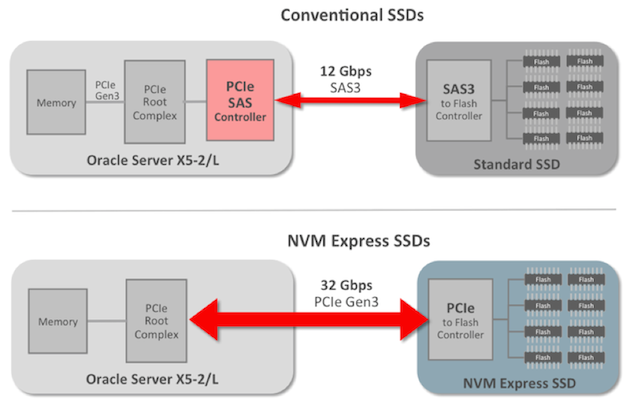This article is more than 1 year old
Oracle bypasses SAS/SATA controllers in flashy new servers
NVM Express said to deliver 32 Gb/sec bandwidth to each SSD
Oracle has revealed two new servers using the NVM Express standard that does away with SAS/SATA controllers in ways the company says makes them perform very, very, well when stocked full of flash.
The basics: the two new beasts are called the X5-2 and the X5-2L. Both are two-socket affairs and use Intel's Xeon E5-2600 v3 silicon. The X5-2 is a 1U pizza box and the X5-2L's form factor lets it stack horizontally or vertically into 2U chassis.
So far, so boring.
The interesting part is NVM Express (NVMe) which Oracle says will “.... improve the bandwidth to each flash drive by over 2.5 times, compared to conventional SSDs ... by eliminating the SAS/SATA controller from the path completely.” Oracle says it's built “ … four PCIe lanes directly to the NVM Express SSD itself” and can therefore “provide 32 Gb/sec bandwidth to each drive.”
This won't work for any old SSD: you need an Oracle NVMe-ready SSD, of which four will fit into a conventional 2.5 in drive bay.

Look, Ma! No SATA or SAS controller!
NVMe requires an “enabling kit” that consumes a PCIe slot. The new technology is installed in four drive bays, and can still address up to 6.4TB of storage in each bay.
NVMe is a standard, so Oracle's not out on its own here. But it clearly believes NVMe delivers the best possible performance for its own software. The new servers are pitched as optimised for Oracle apps and Oracle virtualisation.
Optimisations include something called “Database Smart Flash Cache” that “keeps recently accessed data warm in flash storage, reducing the chance that the database needs to fetch the data from slower magnetic media that may be direct attached or resident on a NAS/SAN fabric.”
It's also possible to add NVMe SSDs to a ZFS hybrid storage pool, and treat the special Oracle flash as a tier.
These new servers seem to have the same strategic intent as many other recently-revealed converged or hypercovnerged rigs, namely to provide a rig optimised for certain workloads. But Oracle's not gone as far with the X5-2 and the X5-2L as it has with its current SPARC silicon, which is also unashamedly optimised for its own software.
The wheel turns. And even a stopped clock is right twice a day. ®
